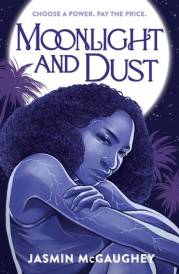Beasts of the Southern Wild
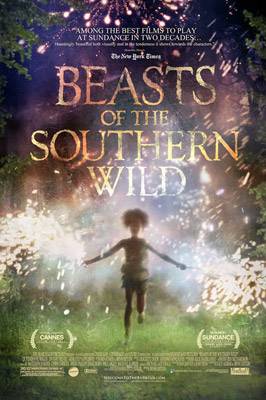
Beasts Of the Southern Wild
Cast: Quvenzhane Wallis, Dwight Henry, Levy EasterlyDirector: Benh Zeitlin
Genre: Drama, Fantasy
Rated: M
Running Time: 93 minutes
Synopsis: In a forgotten but defiant bayou community cut off from the rest of the world by a sprawling levee, six year-old Hushpuppy exists on the brink of orphan hood. Her mother long gone, and her beloved father Wink is a wild man on a perpetual spree. When her father is home, he lives under a different roof: him in a rusted out shack, and her in a trailer propped on two oil drums. More often than not, Hushpuppy is left to her own devices on their isolated compound filled with semi-wild animals. She perceives the natural world to be a fragile web of living, breathing, squirting things, in which the entire universe depends on everything fitting together just right.
Life in the Bathtub is one defined by resilience and celebration. But at the local elementary school (boat), Hushpuppy's no-nonsense teacher Miss Bathsheba educates her ragtag students about natural selection, global warming, and the huge ecological shifts that have pitted their little village on the front line for extinction. Learn to live with one another, and adapt! She instructs. "Y'all better learn how to survive now?"
Reality crashes down on Hushpuppy's little world when her father comes down with a mysterious illness, and nature begins to spiral out of control. A massive storm brews, the ice caps melt, and her dad shakes on the ground at her feet after a mere punch. Hushpuppy becomes convinced that the science attacking her environment and her father's insides are inextricably linked. It's end times in her delicate habitat.
Half a world away, an unforeseen result of these sudden global shifts: fierce prehistoric beasts thaw out of the ice, righting themselves on firm ground after centuries immobile?
As the waters rise around the bayou shrimping town, all the practical people run for higher ground, but Wink and his brigade of drunken sweethearts insist on staying put. He and Hushpuppy are forced to hole up together in Wink's un-sturdy shack and ride through the hurricane, with Wink firing a shotgun into the sky, defying the forces of nature. When morning breaks, the two find a Bathtub destroyed, empty, and almost totally submerged. Wink and Hushpuppy collect the other holdouts, and as is custom, greet their disposition with celebration instead of remorse: they throw a party with all the shrimp, crab, and beer that's left. Miss Bathsheba kills the mood by reminding Wink that the excess of salt water in the Bathtub has likely killed all the flora and fauna that usually provides them with their sustenance they could be consuming the last the bayou has to offer. Wink takes a swig of beer and shrugs her off. "I got it under control." But his attempts to teach Hushpuppy to survive on her own in this changed environment fall short a lesson on how to fish with bare hands leaves her in pain.
The next morning, Hushpuppy is awoken by Wink and company sneaking out with a giant garfish filled with explosives - the crackpot plan being to blow up the levee keeping all the water in and drain out their homeland. Miss Bathsheba, the only one who understands the science of why this is a very bad idea, stops Wink, but not Hushpuppy, from executing the kamikaze scheme. The results are disastrous: the drained Bathtub resembles a mushy, scorched earth-a land formerly bursting with plants and animals is now dead. Though Wink refuses to accept it, Hushpuppy can tell that the fabric of nature has unraveled around her - that the unending harvest of the bayou is over.
The fearsome beasts now cut looming shadows against the horizon and charge their way across continents - snarling, growling, knife sharp horns glimmering as they head south?
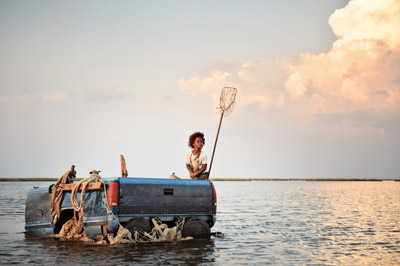 Soon afterwards, the government suddenly reminded of their existence, the Bathtub is subjected to a mandatory evacuation, and men with bullhorns and strange accents whisk away Hushpuppy, Wink, and the other residents of the Bathtub. They are taken to a sterile, gloomy refugee camp hospital, where everyone looks as bleak as "fish in a fish tank without water," according to Hushpuppy. In the care of the state, she is immediately dressed up in unnatural feeling "acceptable" clothes with the other unruly Bathtub kids. Confronted with his diagnosis from the doctors, Wink tries to give Hushpuppy away. Hushpuppy refuses, furious, and Wink must finally tell her the truth: he's dying. At last, it hits Hushpuppy that her father isn't the maniac superman she thinks he is. Out of his natural environment, he begins to cough up blood, and asks for his friends to take him to the only place he knows as home.
Soon afterwards, the government suddenly reminded of their existence, the Bathtub is subjected to a mandatory evacuation, and men with bullhorns and strange accents whisk away Hushpuppy, Wink, and the other residents of the Bathtub. They are taken to a sterile, gloomy refugee camp hospital, where everyone looks as bleak as "fish in a fish tank without water," according to Hushpuppy. In the care of the state, she is immediately dressed up in unnatural feeling "acceptable" clothes with the other unruly Bathtub kids. Confronted with his diagnosis from the doctors, Wink tries to give Hushpuppy away. Hushpuppy refuses, furious, and Wink must finally tell her the truth: he's dying. At last, it hits Hushpuppy that her father isn't the maniac superman she thinks he is. Out of his natural environment, he begins to cough up blood, and asks for his friends to take him to the only place he knows as home.Unable to watch wink on his deathbed, Hushpuppy flees across the water toward a light in the distance she believes to be her mother. A mysterious boatman plucks her out of the sea and takes her to his favorite nightclub, the Elysian Fields Floating Catfish Shack "GIRLS GIRLS GIRLS." As Hushpuppy wanders this ethereal paradise, out of the kitchen steps a woman, who stares at her with eyes that look like hers. "Let me show you a magic trick," she tells Hushpuppy, who's in awe. Whipping up some killer grits n' gator and dishing out no-nonsense advice, she gives Hushpuppy a moment of love she's been looking for her whole life. But as they dance together, Hushpuppy realizes she has a duty to return to her father and The Bathtub before it's too late for both of them.
The creatures suddenly appear on the parched crest before the dried up bayou, a tiny girl in their crosshairs. They charge up behind her, when suddenly she swirls around to face them with eyes as fearless as theirs. They share a moment of primal understanding, and the beasts kneel before her. She goes along her way?
Back in the Bathtub, Hushpuppy shares a last supper of fried gator with Wink in his broken shack. Having reconciled with her father and accepted nature's chosen path, she returns to her friends and family, a hardened warrior, and they parade into the Southern Wild as water laps at their feet.
Release Date: September 13th, 2012
Artistic Statement
Someone's ability to bake doughnuts or laugh loud is just as good a reason to make them a dolly grip as their ability to push a dolly. I want to fill my life and my films with wild, brave, good-hearted people. Whatever amount of chaos and disaster that leads to doesn't matter, because you're going through it with the people you love, and in the end, no matter what, the movies come out wild, brave, and good-hearted and that's more important to me than smooth dolly moves.This concept extended to every part of the process making Beasts of the Southern Wild. My approach to making movies is about crafting an energy, a feeling, and a way of life that the people that make movies with me can live.
It's about inventing a reality and populating it with the best people I know.
Most gloriously, in our casting process - where we chose Dwight Henry, from the bakery across the street, and Quvenzhane Wallis, from Honduras Elementary School to take charge of our heroes, Wink and Hushpuppy.
Neither of them had any previous experience acting, but when you look in their eyes, you see fearless warriors, and you know they can do anything. Even though you then have to re-write the script from scratch and change everything about your approach, it doesn't matter, because those elements were superficial in the face of accurately capturing the fierce spirit that the film needed to articulate. That principle was applied to every decision. Are we going to create an interior water set? Or are we going to sea? Do we dress an accessible location to look like an island at the edge of the world, or do we go to the edge of the world? Do we dress an year-old to look like she's six? Or do we cast a six year-old? We tested the strength of the story and family that made it against every element that would try to break it.
I got hooked on South Louisiana because this mentality is everywhere. I showed up for a two month visit six years ago and I'm not going anywhere. It's the home of the most tenacious people in America - an endangered species. And that fierceness was how I came to this story. With the hurricanes, the oil spills, the land decaying out from under our feet, there's a sense or inevitability that one day it's all going to get wiped off the map. I wanted to make a movie exploring how we should respond to such a death sentence. Not critiquing the politicians who have caused it, or calling to arms for environmental responsibility, or raising awareness of suffering, or any of that. The real question to me, is how do you find the strength to stand by and watch the place that made you die, while maintaining the hope and the joy and the celebratory spirit that defined it? I found the answers in the ferocious people I cast in the film, and I found an incredible articulation of that story in my dear little friend Lucy Alibar's play Juicy and Delicious -- an apocalyptic comedy about a little boy losing his father at the end of the world.
From the two of us, and with the spirit of Quvenzhane Wallis, came Hushpuppy. She's a little beast who, in order to survive, has to find the strength of South Louisiana at the age of six. I put all the wisdom and courage I've got into her. She's the person I want to be.
Background
This production didn't face obstacles it faced impossibilities. So too do the people of the Bathtub, and the real communities that inspired them, persist against all odds - nature, the government, and lack of resources. The characters in Beasts Of The Southern Wild and the people behind its inception don't take on challenges as obstructions challenge is the whole premise. To do, to make, to live - despite everything.
An unholy mix of artists, animators, constructionists, editors, musicians, and storytellers, Court 13 makes movies about unlikely communities, as an unlikely community. And what better place than New Orleans and its attendant bayous, a region that has forged centuries of culture and tradition out of living in a downright improbable environment? Where else do you throw a party to celebrate a storm? Where you have a flamboyant parade when someone dies? Where timeless music makes you stomp your feet on sinking ground? Ever since they made a boat out of junk and sailed it on Lake Pontchartrain for the short film "Glory at Sea," Court 13 has collaborated with the people and places of South Louisiana to create huge stories out of small parts, stories that transcend reality but are built of real people living in un-real circumstances.
However, the endeavour of the making of Beasts Of The Southern Wild was not a solo errand but entirely a partnership between the defiant energy of Court 13 and the determined vision of Cinereach. After acquainting themselves with the filmmakers following "Glory at Sea," Cinereach made sure that the creative fantasies of Benh Zeitlin's next project would actually come true. In accordance with their mission to support "vital stories, artfully told," Cinereach put the filmmakers first, bonded with Court 13 in the philosophy of taking cinematic challenges as opportunities instead of obstacles. They did nothing short of let Benh Zeitlin and his brigade practice what they had seemed to preach on their epic short two years earlier. And presiding as minister over this union was Journeyman Pictures' Paul Mezey, consistently blessing the production with his Jedi-like wisdom and guidance.
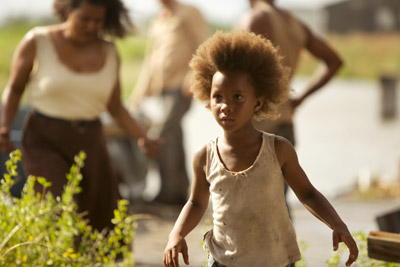 Just as southern Louisiana isn't so much a place as a way of life, so too are Court 13 and Cinereach about much more than just a "different" approach to independent filmmaking. With Beasts Of The Southern Wild, these nebulous ideas were finally put into practice on a large scale. It is Court 13's first feature film.
Just as southern Louisiana isn't so much a place as a way of life, so too are Court 13 and Cinereach about much more than just a "different" approach to independent filmmaking. With Beasts Of The Southern Wild, these nebulous ideas were finally put into practice on a large scale. It is Court 13's first feature film. Origins
Friends since they were teenagers, Benh Zeitlin had always contemplated adapting one of Lucy Alibar's plays into a short film. Alibar wrote pieces that played like delicious concoctions of food, magic, and love, Southern style. Upon seeing a performance of "Juicy and Delicious" in 2008, Benh Zeitlin decided that the scope and spirit of the world Alibar had created, not to mention the particular story, merited transformation into a full-length feature film-what would be his first. Alibar created characters endowed with a specific kind of sweetness, and subjected to a kind of love so tough it might be called cruelty, if you weren't laughing so hard. This dissonance in the relationships between characters is something Alibar and Benh Zeitlin would hold on to as they made the transition to a screenplay. However, while to behold the performance of Alibar's play was to witness something surreal and magical where rules did not apply, Benh Zeitlin approached the story and its telling with realism as a starting point. It was the same realism that informed the style of his 2008 short "Glory at Sea"-but just as what those very true-to-life characters eventually encountered aboard their barely seaworthy junk raft was undeniably fantastical, so too would be what Hushpuppy experienced as her world crumbled around her. At its heart, both play and film would be built on the foundation of a central, all-important quality for their tiny hero: emotional bravery, and the specific kind of courage it takes to say goodbye to someone you love.
Alibar and Benh Zeitlin transplanted this theme to the subsiding landscape of southern Louisiana-a place that prioritizes unadulterated joy and debaucherous appetites even as its towns fill with water and its bayou shores sink away in front of them. The film's scope widened to portray the loss of place as well as person, the demise of Wink now finding a parallel in the demise of his home. A made-up bayou village on the southern edge of the country, the Bathtub wasn't quite based on any specific town, but rather a concentration of all the cultural elements of southern Louisiana in one place. In other words, the Bathtub contained everything good that stood to be taken away by the epic natural shifts going on around it. The question for the character of Hushpuppy became: what responsibility and duty do you have to your home and yourself to be there for someone or something as it slips away in front of you?
Eighty miles southwest of New Orleans and a world away, holed up in a marina literally where the road ends and the Gulf begins, Benh Zeitlin and Alibar hammered out the script. The five bayous that extend south of Houma like fingers into the ocean, the communities of people there (shrimpers, crabbers, oilmen), and the way of life were certainly fertile ground for their imagination, but from the outset the world of the Bathtub was going to be a step away from reality. This isn't to say the writing process didn't occasionally overlap with some premature location scouting: after Benh found an abandoned school bus and rusty oil drum in the back of Claude Bourg's property, lo and behold, Hushpuppy had a home. But Benh Zeitlin was always conscious that tying the film's setting to any particular place or issue would diminish the impact of the story, and that removing any literal frame of reference would open it up to a wider, richer viewing experience. He and Alibar had spun a huge tale in an alternate universe - a universe that probably merited the resources of a $100 million blockbuster to build. How this giant world, and its destruction, could be tailored to a small budget posed one of many seemingly impossible challenges.
Fortunately, the film had been accepted to the Sundance Institute's Directors, Screenwriters and Producers Lab, which prioritises helping filmmakers navigate exactly these kinds of problems. The Screenwriters' Lab was fundamental in the aforementioned transition that Alibar and Benh Zeitlin took their story through, while the Directors' Lab gave Benh Zeitlin the chance to give these new ideas creative ground to grow in. Finally, the Producers' Lab endowed the project with guidance on how to compact the world of the Benh Zeitlin's film into an executable plan. The final blessing was given in the form of the Sundance/NHK International Filmmakers Award for Benh Zeitlin, and the stakes were set. These filmmakers had high ambitions for their film, and there were even higher expectations that they meet them.
The Casting Process
Grand as the scope of the film had become, the audience would be firmly planted in this world through the perspective of a singular, curious beast of a creature named Hushpuppy. The film's success depended entirely on finding someone to fill this character's tiny, but simultaneously massive shoes. And that was the first impossibility encountered-what child could conceivably carry this huge film on her diminutive shoulders?
The search began in early 2009 in New Orleans, in an abandoned classroom set up as an office and audition space, where so many talented kids were found that Court 13 began an after school program to teach them acting and filmmaking. Sessions with girls ages six to nine played out more like interviews and game-playing than it did a traditional movie audition. After four months without a Hushpuppy, the operation expanded beyond the city and into the bayou communities where Benh Zeitlin and Alibar were writing the script, and also where the film would eventually be shot. Ultimately stretching into eight parishes, Court 13's volunteer casting army made it common practice to canvas around a given town, work with local superintendents to pass out flyers in public schools, and hold auditions in area churches and libraries. Four months turned into a year as they combed through every bowling alley, after school program, congregation, and classroom they could find in some areas they even went door to door.
Four thousand kids later, the hard work paid off and they would have themselves a Hushpuppy-and she was right in the film's backyard of Houma, Louisiana, amongst the bayous and the barges that form the backdrop of the movie. And she wasn't between the ages of six to nine she was five when she first auditioned. Clearly endowed with a striking imagination, Quvenzhane Wallis was a micro force of nature with unparalleled focus and emotional intelligence. The full flair of her personality could not be confined by the words "action" and "cut" either she was a hurricane of humour and natural charisma that charmed you no matter who you were.
The next mission was to find the character of Hushpuppy's father, Wink. The audition process for adults was similar to that for kids: mostly an interview about their personal story, then given a scene with circumstances around which to improvise as a character no different than themselves. Only in the last stages of the process, when they were nearly cast, did potential actors carry a script. Again, the concentration was on folks local to New Orleans or the bayou areas, who had never acted before but were intrigued by a flyer in a barbershop or an announcement on local radio.
In reviewing the tapes brought into him by Court 13's volunteer audition squad, Benh Zeitlin kept coming back to one man with a one-of-a-kind smile. Mr. Dwight Henry was a familiar figure, running the delicious bakery across the street from the abandoned school building where the team held auditions. He barely acted at all on his original audition tape, instead spinning incredible stories from post-Katrina New Orleans, and his resilience in pursuing baking. Six months later, desperate to secure him for a callback, the team found him nearly impossible to lock in.
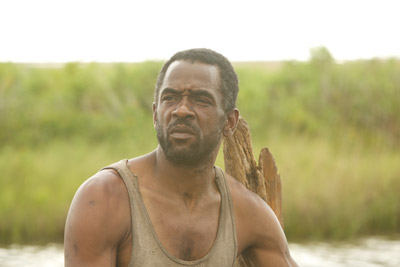 They realised they were calling in the afternoon he worked from midnight to noon-baker hours-and slept afterwards. Once he did come in, he demonstrated a potent emotional vulnerability and commanding screen presence. Benh Zeitlin and the team had always thought that the role might merit a trained professional - but never ones to take the easy way out, they went with Mr. Henry. Rehearsals and sessions with Benh Zeitlin would take place in the bakery, from 2 to 5 in the morning, as he baked. The choice would ultimately weave Mr. Henry's spirit into the fabric of the film in such a way that it's hard to imagine Wink in any other way. He made the role his own.
They realised they were calling in the afternoon he worked from midnight to noon-baker hours-and slept afterwards. Once he did come in, he demonstrated a potent emotional vulnerability and commanding screen presence. Benh Zeitlin and the team had always thought that the role might merit a trained professional - but never ones to take the easy way out, they went with Mr. Henry. Rehearsals and sessions with Benh Zeitlin would take place in the bakery, from 2 to 5 in the morning, as he baked. The choice would ultimately weave Mr. Henry's spirit into the fabric of the film in such a way that it's hard to imagine Wink in any other way. He made the role his own. The rest of the adult cast was rounded out by locals from New Orleans and the area where the corps of the film's operation were starting to build their infrastructure, and complemented by some of the key players from "Glory at Sea." The Bathtub had its residents.
The Aurochs
With the cast falling into place and nearly all of them learning how to act on film for the first time, another set of performers had to be wrangled and another challenge surmounted. One of the main elements of Alibar and Benh Zeitlin's script that defined it as a larger-than-your-usual-independent film were the mythical, fierce, doomsday creatures known as Aurochs. The conceit of the mythology of the film was that these pre-historic animals had frozen in glaciers long ago, only to thaw and be resurrected by the massive climate shifts we see taking place in the Bathtub. How do you create a parade of monsters that herald the impending apocalypse, on a less than monstrous budget? As Benh Zeitlin's crew gathered in the bayou, a second unit based in New Orleans had this question to answer.
The scene played out in an abandoned firehouse in the Marigny that was provided by a fellow Sundance Institute alum and renowned regional filmmaker-the godfather of the independent film scene in New Orleans. It was like a laboratory, with giant water tanks, laser-cut miniature towns, and animal pens in the backyard. This was because the first step was to gather the Aurochs' living, breathing surrogates, a handful of wild animals, to be trained to perform for the camera. The second step was to deck these creatures in tailor made head-dresses, specially designed to endow the wide-eyed creatures with fearsome horns and shaggy hair. The story of the Aurochs would play out against the backdrops of miniature ice age sets that had to be meticulously constructed. Certain greenscreen shots even called for a conveyor belt surface for the mangy mammals to trot along, an apparatus operated by a crew member on an exercise bike. Problem solved.
Production
In January 2010, the Court planted its flag in its new bayou headquarters - 517 Highway 55, in Montegut, Louisiana, formerly known as Claude Bourg's Cajun Country Stop & pumping station. A diamond in the mud, this property suited the film's needs perfectly: the former convenience shop became the office, the 18 wheeler garage housed the art department, the shrimp cleaning facilities was be the prop area, and as it turns out, one third of the movie would end up being shot in Claude's backyard. Another third, no further than 15 minutes away from it. After taking a moment to recover from the Saints' miraculous Super Bowl win in February, the corps of the Court traded in sleeping bags and space heaters on the floor of Claude's convenience store for bunk beds in the fishing camps behind it. Likeminded members of the larger crew began to wash ashore on the bayou across the highway, to begin pre-production work. The brigade was a peculiar hybrid of Louisiana locals, independent film world professionals, and friends of friends just up for an adventure what they shared was a dedication to the particularly immersive experience that telling this story required. By the end of pre-production, there were more than 80 crew members-half of them in the Art Department alone-and all scattered in housing along the bayous. Nights were spent picking apart crawfish on a huge spread of newspaper, and washing them down around the campfire in Claude's backyard. Lucy even staged a reading of her original play in the mechanics' garage it was just one of many instalments of "Family Fun Night." With each new recruit, there were more animals gathered, more boats and vehicles secured, more elaborate sets constructed, more costumes tailored? A generous truckload of grip equipment provided by a grant from friends Rooftop Films and Eastern Effects made life easier for the G & E department. All the while, the art department's crown jewel, a giant school boat-come-warship, sat in the bayou by the gas station office, bewildering every local that passed.
Principal photography began on April 20th, a date better known in Louisiana for what also happened that day: the disastrous BP Deepwater Horizon oil spill, just a hundred miles southeast of the film's bayou home. The production forged ahead, shooting 40 days in and near the waterways of Montegut, Houma, Bourg, and Pointe- Aux-Chenes, as well as Mandeville and Slidell taking it up to the North Shore then it was seven days back in New Orleans for second unit and special effects photography with the Aurochs. In the bayou, every day posed a new titanic struggle against the elements: days were long, the air was thick, the boats would break, the eight year-olds were cranky, Wink threw out his voice, the food was dehabilitatingly delicious you name a problem, they had it and then some. The Court 13 mantra of making do out of what's around you proved key. The team went through about 15 different iterations of the shoot schedule. There were explosions, an encounter with the FBI, various vehicles that went up in flames when they weren't supposed to, various vehicles that didn't go up in flames when they were supposed to, truculent neighbours armed with shotguns, a giant oil corporation that kicked the production out of a key location to clean up the mess they had made offshore? And the thing keeping the whole ship afloat was the perseverance and spirit of a tiny six year-old. She passed the trying test of the film shoot with flying colours, and then asked for more.
Post Production
Benh Zeitlin and his editor had a mountain of footage to get through. An enormous assembly cut put out every single scene and storyline that Benh Zeitlin had intended to follow, and for months upon months the task was whittling the footage down into a film that told the story most effectively. As one of the two composers, and not one to go uninvolved in any other step of post-production either, Benh Zeitlin had his work cut out for him. When the deadline for Sundance loomed in September of 2010, the decision was made that in order to allow Benh Zeitlin to carefully take his film through each process, post-production would need another year.
The lions' share of that year was in fact spent on just getting to picture lock, and a definitive discovery: the movie was at its heart about Hushpuppy and her father. Fortunately another miracle had occurred in the securing of the San Francisco Film Society's Kenneth Rainin Foundation post-production grant, which had led to the film enlisting top talent Bay Area visual effects artists to finally bring the Aurochs footage into coexistence with the rest of the film. Later, with some serious believers at the Film Society, the film won the grant again in the second year of its post-production, through which it was able to partner with Bay Area behemoth Skywalker Labs for sound work.
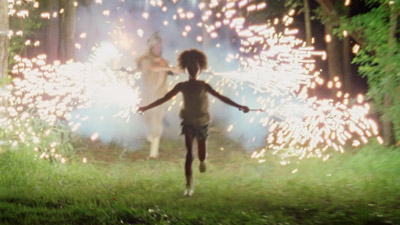 For a small film from Louisiana attempting to portray something cinematically much larger than its tiny parts, this was a gift from heaven.
For a small film from Louisiana attempting to portray something cinematically much larger than its tiny parts, this was a gift from heaven. Finally, Benh Zeitlin sat down with his collaborator to write the score, as each of these phases began to spin concurrently in late 2011. The duo had written the score to "Glory at Sea," which had found warm reception beyond the film, everywhere from Obama for America campaign videos in 2008 to a Google Chrome commercial. The key this time would be to articulate musically both Hushpuppy's imagination and emotional state as the world fell apart around her. They would enlist a legendary regional band from Louisiana for the Bathtub sound, but the question at hand would be: when Hushpuppy opened the peculiar music box of her world for the audience, what was the melody that would come out?
They found an answer, and eventually the Bathtub had an epic, sprawling soundscape, visual magic to bring in the beastly harbingers of its doom, and the tune of its own hero becoming a warrior. The last adjustments were made at the final sound mix in Marin County the film ended in the Bay that had begun in the bayou.
MORE



